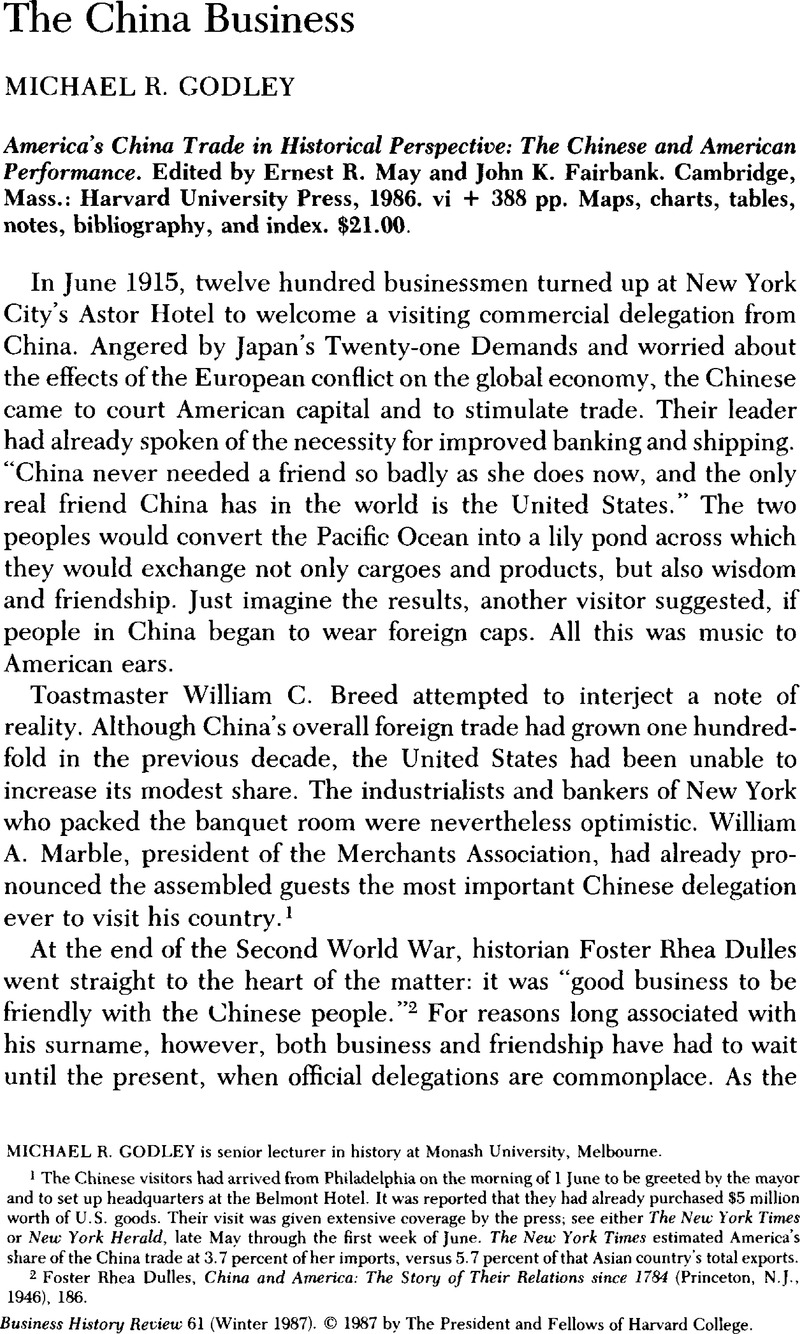No CrossRef data available.
Article contents
The China Business
Published online by Cambridge University Press: 11 June 2012
Abstract

- Type
- Review Essays
- Information
- Copyright
- Copyright © The President and Fellows of Harvard College 1987
References
1 The Chinese visitors had arrived from Philadelphia on the morning of 1 June to be greeted by the mayor and to set up headquarters at the Belmont Hotel. It was reported that they had already purchased $5 million worth of U.S. goods. Their visit was given extensive coverage by the press; see either The New York Times or New York Herald, late May through the first week of June. The New York Times estimated America's share of the China trade at 3.7 percent of her imports, versus 5.7 percent of that Asian country's total exports.
2 Dulles, Foster Rhea, China and America: The Story of Their Relations since 1784 (Princeton, N.J., 1946), 186Google Scholar.
3 Li, Lillian, China's Silk Trade: Traditional Industry in the Modern World, 1842–1937 (Cambridge, Mass., 1981)CrossRefGoogle Scholar. One criticism that might be leveled at the May and Fairbank book is that most of the chapters only summarize their authors' book-length works, five of which were published by Harvard University Press. But the goal, I think, is a worthy one: to package specialist writings for a broader audience. Nevertheless, Harvard University has made something of a business of China.
4 Chao, Kang, The Development of Cotton Textile Production in China (Cambridge, Mass., 1977)CrossRefGoogle Scholar.
5 Cochran, Sherman, Big Business in China: Sino-Foreign Rivalry in the Cigarette Industry, 1890–1930 (Cambridge, Mass., 1980)Google Scholar.
6 See the analysis in Varg, Paul A., The Making of a Myth: The United States and China, 1897–1912 (East Lansing, Mich., 1968)Google Scholar, and the review by McCormick, Thomas J., “American Expansionism in China,” American Historical Review 85 (June 1970): 1393–96CrossRefGoogle Scholar. I have not dealt with the very important questions of American motivations or how the China Trade has been interpreted by historians, because I could not equal the analysis already provided by Michael H. Hunt in his first-class essay, “Americans in the China Market: Economic Opportunities and Economic Nationalism, 1890s–1931,” Business History Review 51 (Autumn 1972): 277–307Google Scholar.
7 See Anderson, Irvine H. Jr, The Standard-Vacuum Oil Company and United States East Asian Policy, 1933–1941 (Princeton, N.J., 1975)Google Scholar.
8 Esherick, Read Joseph, “Harvard on China: The Apologists of Imperialism,” Bulletin of Concerned Asian Scholars, 4 (Dec. 1972): 9–16Google Scholar, or, in the same publication, Cheryl Payer, “Harvard on China II: Logic, Evidence and Ideology,” ibid. 6 (April–Aug. 1974): 62–68, and Mark Selden, “American Global Enterprise and Asia,” ibid. 7 (April–June 1975), 15–33.
9 For example, Best, Gary Dean, “Ideas without Capital: James H. Wilson and East Asia, 1885–1910,” Pacific Historical Review 49 (1980): 453–70CrossRefGoogle Scholar.
10 See section 1, “From the Empress of China to the First Open Door Notes, 1784–1899,” in American-East Asian Relations. A Survey, ed. May, Ernest R. and Thomson, James C. Jr, (Cambridge, Mass., 1972), 3–96CrossRefGoogle Scholar, and Fairbank's, John K. own brand of revisionist history, “American China Policy to 1898: A Misconception,” Pacific Historical Review 39 (1970): 409–20CrossRefGoogle Scholar.
11 The author of one Renmin ribao (People's Daily) article, 10 May 1984, put it bluntly: “From a historical point of view, we have had more failures than successes in our dealings with foreign countries…. But the present is not the past.” “How can you catch tiger cubs,” he asked, quoting an old proverb, “without entering the tiger's lair?” Five months later another author agreed: “There simply cannot be a country stupid enough to refuse knowledge and technology from outside and want instead to close its doors to the outside world and do everything from scratch” (Oct. 15). For more on the academic debate, see Allen, G. C. and Donnithorne, Audrey G., Western Enterprise in Far Eastern Economic Development (London, 1954)Google Scholar, Hou, Chi-ming, Foreign Investment and Economic Development in China, 1840–1937 (Cambridge, Mass., 1965)CrossRefGoogle Scholar; Dernberger, Robert F., “The Role of the Foreigner in China's Economic Development, 1840–1949,” in China's Modern Economy in Historical Perspective, ed. Perkins, Dwight H. (Palo Alto, Calif., 1975)Google Scholar; and Wright's, Tim brilliant essay, “Imperialism and the Chinese Economy: A Methodological Critique of the Debate,” Bulletin of Concerned Asian Scholars 18 (Jan.–March 1986): 36–45Google Scholar.
12 Wilkins, Mira, The Emergence of Multinational Enterprise: American Business Abroad from the Colonial Era to 1914 (Cambridge, Mass., 1970Google Scholar) and The Maturing of Multinational Enterprise: American Business Abroad from 1914 to 1970 (Cambridge, Mass., 1974)Google Scholar.


